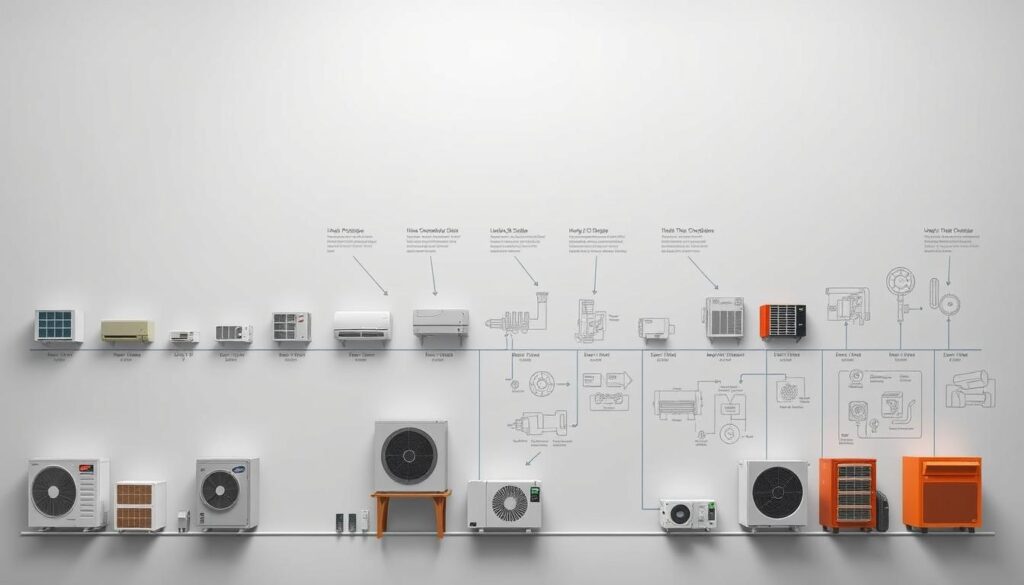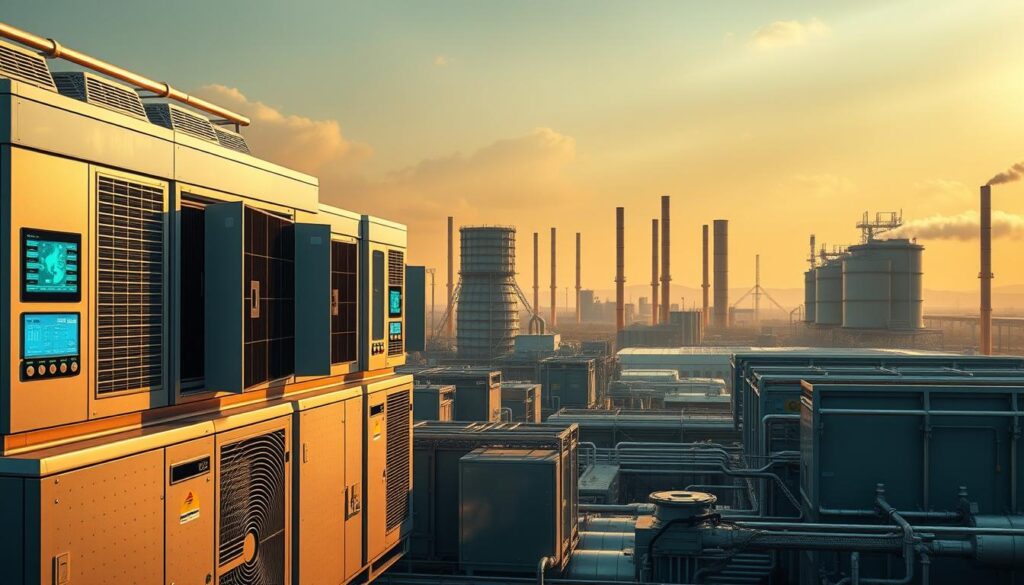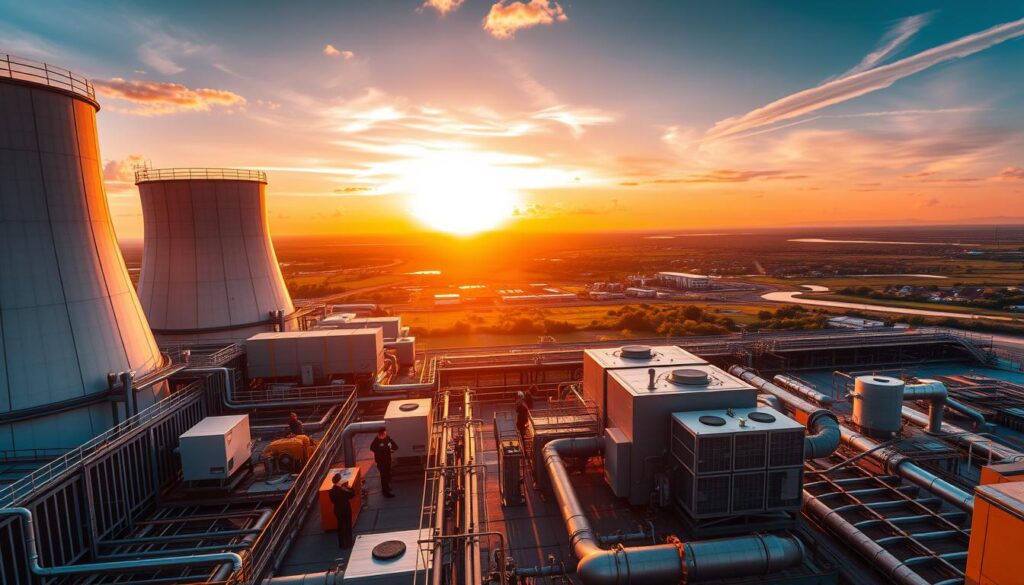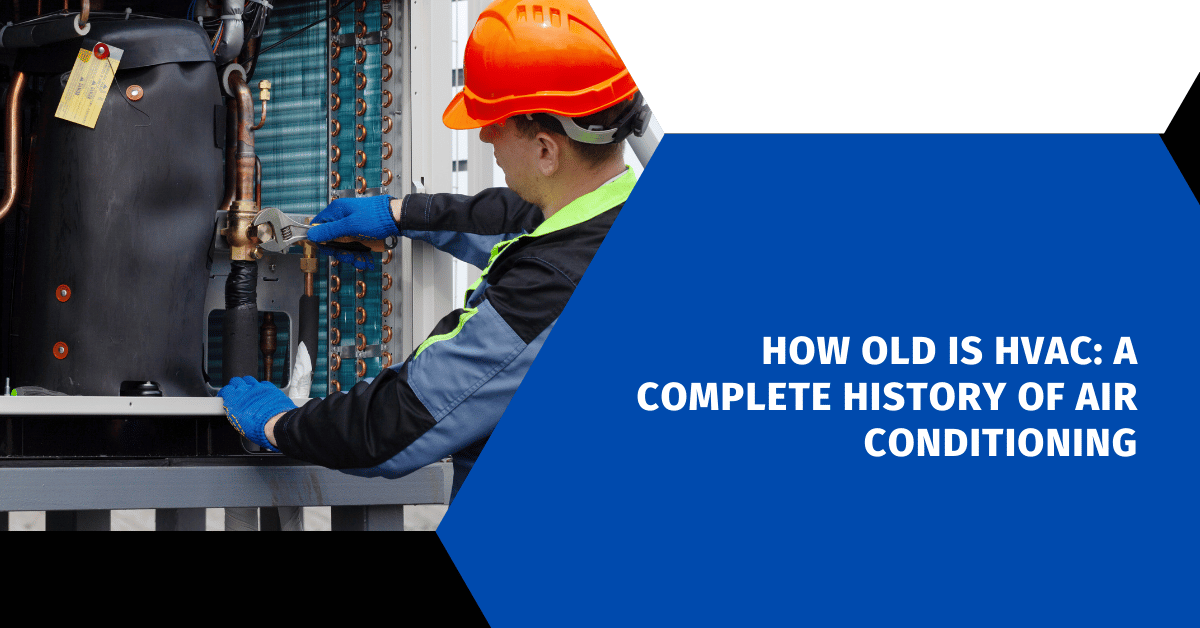Affiliate Disclosure
HVAC Guide Guys is a participant in the Amazon Services LLC Associates Program, an affiliate advertising program designed to provide a means for sites to earn advertising fees by advertising and linking to Amazon.
How Old Is HVAC? Ever thought about how long we’ve been controlling indoor temperatures? The story of HVAC is quite interesting. It shows how far humans have come in innovation and technology.

Air conditioning has changed our lives in big ways. It started simple but is now key to our comfort. Willis Carrier’s 1902 invention was a big leap forward in indoor comfort.
Looking into HVAC’s past is more than just about machines. It’s about the smart ideas that have changed our homes and workplaces. Each step forward in HVAC shows our drive for better comfort and efficiency.
Key Takeaways
- HVAC technology dates back to early 20th century innovations
- Willis Carrier pioneered modern air conditioning in 1902
- Temperature control has dramatically transformed human living spaces
- Technological advancements continue to improve HVAC efficiency
- Understanding HVAC history helps appreciate modern comfort technologies
Table of Contents
The Birth of Modern Air Conditioning
The journey of HVAC technology started with dreamers who wanted to control indoor temperatures. Early cooling experiments changed how we live, work, and interact with our surroundings. This story shows the power of human creativity.
Dr. John Gorrie’s Early Cooling Experiments
In the 1840s, Dr. John Gorrie made big steps in cooling tech. He built a machine to make ice using compression, aiming to make hospitals more comfortable. He also dreamed of cooling whole cities with machines.
- Proposed cooling mechanisms for hospitals
- Developed early compression-based cooling technology
- Envisioned large-scale urban cooling solutions
Willis Carrier’s Groundbreaking Invention
In 1902, Willis Carrier created the first modern electrical air conditioner. His “Apparatus for Treating Air” changed how we control temperature and humidity in buildings.
The First Industrial Applications
Carrier’s invention quickly helped many industries. Printing plants, textile makers, and drug companies were among the first to use it. These early uses showed the huge promise of controlled environments.
“Control air and you control the future of industry” – Willis Carrier
- Printing industry temperature control
- Textile manufacturing environment management
- Pharmaceutical production optimization
These early efforts set the stage for today’s HVAC systems. They changed how we experience indoor spaces and paved the way for ongoing tech advancements.
Explore Our HVAC Shop
Looking for top-rated HVAC tools, parts, and accessories? Visit our shop and find the perfect solution for your needs.
Visit the ShopHow Old Is HVAC: Timeline of Innovation
Exploring the age of HVAC equipment shows a journey of amazing progress. It started simple and has grown into today’s advanced systems. This journey highlights human creativity and the quest for comfort.
Important moments in HVAC history show big leaps forward:
- 1902: Willis Carrier invents modern air conditioning, changing indoor climate control
- 1928: First room air conditioners are introduced for homes
- 1930s: Refrigeration tech makes HVAC systems better
- 1950s: Central air conditioning becomes common in American homes
- 1970s: Energy-saving standards change how HVAC equipment is made
Over time, HVAC tech has gotten better in many ways. Early units were big and used a lot of energy. Now, they are smaller and more efficient, controlling temperature precisely.
Looking at the age of HVAC units shows how cooling and heating have changed. From new ideas to key parts of our homes and businesses, each year brought big improvements. These made indoor spaces more comfortable and energy-smart.
“The history of HVAC is a testament to human creativity in solving complex environmental challenges.” – HVAC Engineering Quarterly
Today’s HVAC systems are the result of years of research and improvement. They offer unmatched comfort and are better for the planet.
Early Commercial Applications and Growth
The growth of HVAC systems changed American comfort and technology. Air conditioning moved from being an industrial wonder to a common need in many areas.
Movie Theaters and Public Spaces
In the 1920s, movie theaters were the first big places to use air conditioning. Owners saw that happy customers spent more. This was a big step in cooling public spaces.
“Cool comfort became a powerful marketing tool for entertainment venues.” – HVAC Historical Society
- First public air-conditioned theaters appeared in major urban centers
- Cooling systems attracted audiences during hot summer months
- Theaters became social gathering spaces with controlled temperatures
First Residential Systems
At first, HVAC systems were only for the rich in their homes. But, after World War II, more people could afford them.
Post-War Expansion
After World War II, HVAC technology grew fast. People moved to warmer places like Florida because of better cooling. New homes started to come with central air systems.
- 1950s saw widespread residential air conditioning adoption
- Technological improvements reduced system costs
- Suburban housing boom coincided with HVAC advancements
By the 1960s, air conditioning was no longer a luxury but a must-have in American homes and businesses.
Explore Our HVAC Shop
Looking for top-rated HVAC tools, parts, and accessories? Visit our shop and find the perfect solution for your needs.
Visit the ShopEvolution of Cooling Technologies

The journey of HVAC technologies is a story of constant innovation. Your home’s comfort system has changed a lot over the years. Each new technology has made systems more durable and efficient.
Early cooling methods were simple but not very effective. Refrigeration systems got a big boost with new coolants. These changes made systems work better and last longer.
- Refrigerant innovations dramatically reduced environmental impact
- Compressor designs became more energy-efficient
- Smart control systems enhanced overall system performance
The switch from old coolants to new ones was a big step. It was driven by concerns for the environment. This change helped protect our planet and made systems more reliable.
“Innovation drives the future of cooling technologies” – HVAC Engineering Quarterly
Today’s HVAC systems use advanced materials and smart controls. These changes have turned cooling into a high-tech field. Now, systems are not just about cooling but also about saving energy and meeting your needs.
Your HVAC system today is the result of years of improvement. It offers unmatched comfort, efficiency, and reliability.
Residential HVAC Development
The evolution of residential HVAC has changed how Americans feel at home. It’s interesting to see how old HVAC systems are. This journey of innovation has greatly impacted our daily lives.
As HVAC technology grew, home cooling solutions changed a lot. The mid-20th century was a key time. It brought new comfort to American homes.
Window Units Revolution
In the 1950s, window air conditioners started a cooling revolution. These small units made air conditioning affordable for the first time. They were a big deal for middle-class families.
- Affordable pricing
- Easy installation
- Compact design for small spaces
Central Air Systems
By the late 1960s, central air systems became the norm. They offered better cooling and energy use. They also looked nicer than window units.
- Whole-home cooling
- Improved energy efficiency
- Enhanced aesthetic appeal
Modern Smart Technology Integration
Today’s HVAC systems are the best for home climate control. They use smart tech for:
- Remote temperature control
- Energy consumption tracking
- Automated climate management
| Decade | HVAC Technology | Key Innovations |
|---|---|---|
| 1950s | Window Units | Affordable Home Cooling |
| 1960s | Central Air Systems | Whole-Home Climate Control |
| 2020s | Smart HVAC | IoT and AI Integration |
The journey of residential HVAC shows amazing progress. It has moved from simple window units to smart, advanced systems.
Explore Our HVAC Shop
Looking for top-rated HVAC tools, parts, and accessories? Visit our shop and find the perfect solution for your needs.
Visit the ShopEnvironmental Impact and Refrigerant Evolution

The world of HVAC systems has grown with a focus on the environment. Your HVAC’s life and how well it works have changed a lot. This is thanks to new laws and tech breakthroughs.
Refrigerant tech has been a big step forward for HVAC and the planet. Old HVAC systems used CFCs, which hurt the ozone layer badly. The Montreal Protocol in 1987 was a big change. It made companies think differently about their HVAC systems and the planet.
- 1970s: CFCs widely used in HVAC systems
- 1987: Montreal Protocol initiated global refrigerant phase-out
- 1990s: Introduction of hydrochlorofluorocarbons (HCFCs)
- 2000s: Transition to hydrofluorocarbons (HFCs)
- 2020s: Emerging eco-friendly refrigerant alternatives
Today, HVAC tech focuses on saving energy and cutting down on carbon. Companies make systems that last longer and harm the environment less. They use smart tech to work better and be kinder to the planet.
“The future of HVAC is green, efficient, and environmentally responsible.” – HVAC Industry Expert
Your HVAC system probably uses new refrigerants like R-410A or newer options like R-32. These new ones have much less impact on global warming than old ones.
Industrial and Commercial HVAC Advancements
The world of industrial and commercial HVAC systems has changed a lot in recent years. As buildings get more complex, knowing the age of the HVAC equipment is key. It helps in controlling the climate and improving performance.
Today, commercial spaces need advanced cooling solutions. These go beyond just controlling temperature. The age of the HVAC unit is now very important. It shows how well a system can work and save energy.
Skyscraper Climate Control
Skyscrapers face special challenges when it comes to managing the climate. Engineers have come up with new ways to tackle these issues:
- Zoned temperature control systems
- Advanced air circulation mechanisms
- Pressure-balanced ventilation techniques
Data Center Cooling Solutions
Data centers need precise cooling to keep their electronics safe. Cutting-edge HVAC technologies offer:
- Micro-climate temperature regulation
- Redundant cooling systems
- Energy-efficient refrigeration methods
Modern Building Management Systems
Modern building management systems have changed how we control the environment in commercial spaces. These systems allow for real-time monitoring and predictive maintenance. They also optimize HVAC performance seamlessly.
The future of industrial HVAC lies in smart, adaptive technologies that respond dynamically to changing environmental needs.
Explore Our HVAC Shop
Looking for top-rated HVAC tools, parts, and accessories? Visit our shop and find the perfect solution for your needs.
Visit the ShopGlobal HVAC Market Growth
The HVAC market has grown a lot, becoming key to our modern world. Knowing when to install or replace HVAC systems is more important than ever. This is because the industry is growing fast.
Studies show the market is growing in many places. People want systems that save energy, leading to new technologies in climate control.
- North American market expected to reach $29 billion by 2026
- Asia-Pacific region showing fastest HVAC technology adoption
- Emerging economies investing heavily in advanced cooling solutions
More people living in cities and higher standards of living help the HVAC market grow. Your home’s comfort now relies on advanced technologies that were unimaginable a few decades ago.
| Region | Market Growth Rate | Key Drivers |
|---|---|---|
| United States | 5.2% annually | Residential construction |
| China | 8.7% annually | Industrial development |
| India | 11.3% annually | Infrastructure expansion |
“The future of HVAC is not just about cooling, but creating intelligent, sustainable environments.” – HVAC Industry Forecast 2025
Smart technology is changing HVAC systems. Your hvac replacement timeline now includes smart, energy-saving options. These systems can adjust to environmental changes.
Conclusion
HVAC technology has a fascinating history of human creativity and progress. It started with Dr. John Gorrie’s early work and has grown into today’s advanced climate control systems. These systems have evolved from simple cooling ideas to complex technologies that change how we live and work.
Knowing how long HVAC systems last helps you make better choices about upkeep and updates. Today’s systems use less energy and are better for the planet. They also control the climate better than ever before.
Looking ahead, new trends like smart homes and green energy will change HVAC even more. Companies are making systems that are good for the planet and keep us comfortable. Your HVAC system is now a key part of your home’s technology, linking comfort, efficiency, and caring for the environment.
HVAC technology keeps getting better, showing our skill in solving big problems with smart designs. These systems are vital in homes, offices, and factories. They help shape our daily lives and how we interact with our surroundings.

